Optical Fiber
The Key to High_Speed digital Transmissions
Part 1 of 2
Our Current State
In our modern, interconnected world, high-speed data transmissions serve as the fundamental infrastructure supporting our digital interactions. Committed wire and cable manufacturers, like those participating in DPL Labs high-performance testing programs, continually push the boundaries for higher data rates and longer-distance applications. Meeting these needs and ensuring thorough testing and support are vital steps in enhancing product performance and reliability.
This article aims to highlight how advancements in optical fiber technology is enhancing transmission line performance and reliability in consumer electronics, particularly in digital video transmissions. By incorporating 40 years of optical fiber development, we can see significant improvements in this field.
In the first part of this two-part series, we will explore the history of optical fiber from its inception and trace its advancements in global communications.
What’s on the Optical Fiber Horizon
From streaming videos to online gaming and telemedicine, the demand for fast and dependable data transmission is on the rise. However, achieving and sustaining high-speed data transmissions is a multifaceted  endeavor, necessitating advancements in technology, infrastructure development, and regulatory frameworks. What does the contemporary terrain look like for high-speed data transmissions? What hurdles stand in our way, and what prospects lie ahead?
endeavor, necessitating advancements in technology, infrastructure development, and regulatory frameworks. What does the contemporary terrain look like for high-speed data transmissions? What hurdles stand in our way, and what prospects lie ahead?
Significant milestones and technological advancements have punctuated the progression towards high-speed data transmissions. The shift from dial-up internet to broadband and consumer video to High-Speed signaling transmissions represents a groundbreaking leap in data transmission speeds, facilitating quicker access to online content and services. Subsequent innovations, including the deployment of fiber-optic networks and the evolution of 4G LTE and 5G wireless technologies, have further heightened data transmission speeds while simultaneously reducing latency.
However, to attain the data rates demanded by current usage patterns and projected future needs, the utilization of point-to-point transmission lines capable of accommodating these substantial transfer rates becomes imperative. In this realm, only two alternatives exhibit the physical properties necessary for achieving such speeds copper wire connections or optical fiber. These medi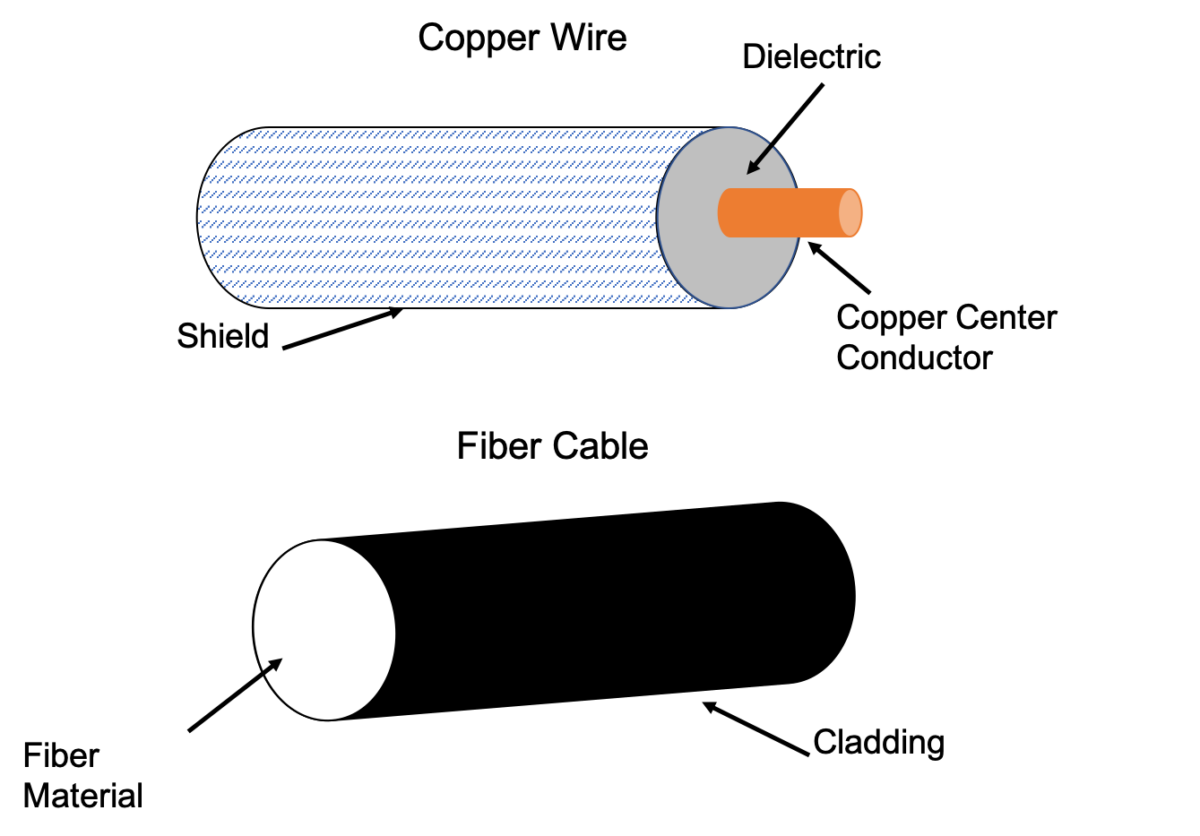 ms possess the capability to support the demanding physics required for high-speed data transmissions and ensure a seamless point-to-point flow of data. Nevertheless, with the adoption of more aggressive data rates, optical fiber will remain the primary conduit for transmitting high-speed signals over distances exceeding 1 to 2 meters.
ms possess the capability to support the demanding physics required for high-speed data transmissions and ensure a seamless point-to-point flow of data. Nevertheless, with the adoption of more aggressive data rates, optical fiber will remain the primary conduit for transmitting high-speed signals over distances exceeding 1 to 2 meters.
A Brief Lesson in Optical Fiber
The extraordinary capabilities of optical fiber arise from Snell’s Law, a fundamental principle of refraction attributed to Willebrord Snellius. Refraction is the bending of light as it passes between different media.
Bending of Light: Snell’s law demonstrates that light bends when it passes from one medium to another with a different refractive index. This bending is the result of changes in the speed of light as it transitions between different materials.
Critical Angle: Snell’s law also reveals the critical angle, which is the angle of incidence beyond which light undergoes total internal reflection rather than refraction. This critical angle depends on the refractive indices of the two mediums involved.
When light transitions from air to water, the refracted ray bends toward the 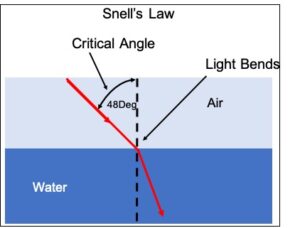 perpendicular. Conversely, when the ray moves from water to air, it bends away from the perpendicular. If the angle at which the ray enters the water is close to perpendicular but greater than approximately 48 degrees, the ray will undergo total internal reflection at the water’s surface and will not exit. This angle, known as the critical angle of the medium, marks the limit beyond which total reflection occurs. Comparisons with other isotropic materials can provide insights into their respective critical angles and optical behaviors through air such as:
perpendicular. Conversely, when the ray moves from water to air, it bends away from the perpendicular. If the angle at which the ray enters the water is close to perpendicular but greater than approximately 48 degrees, the ray will undergo total internal reflection at the water’s surface and will not exit. This angle, known as the critical angle of the medium, marks the limit beyond which total reflection occurs. Comparisons with other isotropic materials can provide insights into their respective critical angles and optical behaviors through air such as:

Physical experiments with Refraction trace back to the pioneering work of Colladon and Babinet in the 19th century. In the early 1840s both Danial Colladon, a Swiss physicist, and Jacques Babinet, a French physicist, independently conducted experiments that demonstrated the principle of guiding lig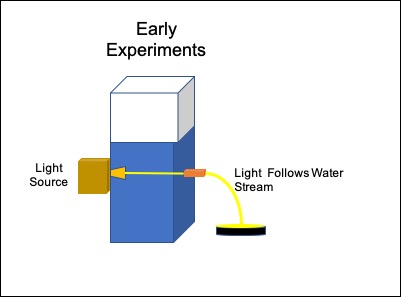 ht through a stream of water. Colladon, in particular, is credited with conducting the first practical experiment illustrating the internal reflection of light within a jet of water exiting a tank of water. 12 years later in London Tyndall demonstrated these experiments in public lectures and writing an introductory book on the nature of light. The experiment positions the light emitter in line with the jet opening allowing the light to follow the curvature of the stream of water as it exits the tank. Their groundbreaking experiments laid the foundation for this technology that would revolutionize telecommunications, enabling the transmission of vast amounts of data over long distances with unprecedented speed and reliability.
ht through a stream of water. Colladon, in particular, is credited with conducting the first practical experiment illustrating the internal reflection of light within a jet of water exiting a tank of water. 12 years later in London Tyndall demonstrated these experiments in public lectures and writing an introductory book on the nature of light. The experiment positions the light emitter in line with the jet opening allowing the light to follow the curvature of the stream of water as it exits the tank. Their groundbreaking experiments laid the foundation for this technology that would revolutionize telecommunications, enabling the transmission of vast amounts of data over long distances with unprecedented speed and reliability.
Fiber Optics in the 20th Century
The 20th century saw incremental advancements in fiber optics, driven by the demand for improved telecommunications infrastructure. In the 1950s and 1960s, researchers made significant strides in developing optical fibers made of glass, capable of transmitting light over longer distances with minimal loss.
It was here in the early 1960s when Charles Kuen Kao, a visionary scientist and engineer, made groundbreaking contributions to the field of optical fiber communication during his tenure at Standard Telecommunications Laboratories (STL) in the United Kingdom. Here, Kao embarked on pioneering research to overcome the limitations of copper wire communication. Recognizing the potential of optical fibers as a transmission medium, Kao focused his efforts on understanding and mitigating signal loss in optical fibers.
His pioneering research laid the foundation for the development of fiber-optic technology, revolutionizing global telecommunications and earning him the title “Father of Fiber Optics.” Kao’s most significant contribution came in 1966 when he published a seminal paper outlining the feasibility of using optical fibers for long-distance communication. He identified the primary cause of signal loss in optical fibers as impurities and imperfections in the glass material. In the 1970s, a pivotal breakthrough in fiber-optic communication emerged as technological advancements rendered it commercially feasible. The development of low-loss optical fibers, along with the invention of semiconductor lasers and optical detectors, paved the way for the deployment of fiber-optic networks for long-distance communication.
Optical Fiber Material from a Historical Perspective
The evolution of optical fiber materials represents a fascinating journey of innovation and technological advancement. From the early days of experimentation with glass to the development of specialized compositions tailored for specific applications, the quest for superior optical performance has driven continuous progress in fiber optics. Beginning with the early experimentation of Colladon and Babinet glass and water demonstrated the principle of light guidance and laid the groundwork for the development of practical optical fibers.
Initially, fiber attenuation stood at an exceedingly high level (> 1000 dB/km), but in 1970, Corning Glass Works achieved a dramatic improvement, reducing it to 20 dB/km. By the early 1980s, InGaAsP (Indium Gallium Arsenide Phosphide) Laser (Light Amplification Stimulated Emission of Radiation) was introduced for data transmission, emitting light at 1300 nm, where fiber loss dropped to below 1 dB/km! This was due to the utilization of both the InGaAsP Laser and the introduction of graded-index multi-mode fibers, single-mode fibers, WDM (Wave Division Multiplex), and SDM (Space Division Multiplex). Optical fiber expanded to even include NASA using fiber optics in television cameras sent to the moon in the late 60’s. Fiber developments and advancements continue with better materials and formulations such as:
Silica Glass: Silica glass emerged as the standard material for optical fibers due to its excellent optical properties, low attenuation, and chemical stability. In the 1960s, researchers at Corning Glass Works (now Corning Incorporated) made significant advancements in manufacturing high-purity silica glass fibers, paving the way for the commercialization of fiber-optic communication systems.
Specialized Fiber Materials: In addition to silica glass, researchers have explored a variety of specialized materials to enhance the performance of optical fibers for specific applications. This includes materials such as plastic optical fibers (POFs), which offer flexibility and cost-effectiveness for short-range communication, and photonic crystal fibers (PCFs), engineered to control light propagation for advanced optical sensing and imaging.
Advancements in Material Science: Advancements in material science continue to drive innovation in optical fiber materials. Researchers are exploring new materials and nanotechnology-based approaches to further improve the performance, bandwidth, and reliability of optical fibers. This includes the development of novel materials with enhanced nonlinear optical properties and improved resistance to environmental factors.
Multimode and Single-Mode Fibers
The evolution of optical fiber materials led to the development of two types of fiber optics, single-mode, and multi-mode, each optimized for specific transmission requirements.
Single-Mode Fiber: Single-mode fibers offer significantly higher bandwidth compared to multi-mode fibers. This is because they have a smaller core diameter (typically around 8-10 microns) which allows only one mode of light to propagate. This results in less interference, higher data transmission rates, and almost zero mode dispersion. It is also capable of transmitting data over much longer distances without significant loss of signal quality. Although significantly higher in cost their performance is exceptional for long-haul telecommunications, undersea cables, and metropolitan area networks.

Structure and Characteristics: Single-mode optical fiber is characterized by its small core diameter, which allows only one mode of light to propagate. Key characteristics include:
1. Core Diameter: Typically, about 8-10 microns, about the same size as spider silk.
2. Cladding Diameter: Standardized at 125 microns and providing a uniform structure that is compatible with existing splicing and connector technologies.
3. Numerical Aperture (NA): Single-mode fibers have a lower NA indicating a smaller acceptance angle for incoming light. This helps maintain the purity of the light signal over long distances.
4. Wave Division Multiplex: Heavily used with Single-mode fiber.
5. Model Dispersion: Single-mode fiber exhibits no model dispersion
Numerical Aperture
Numerical Aperture is a measurement of the light-gathering ability of an optical fiber. It also indicates how easy it is to couple light into a fiber.
Wave Division Multiplexing
(WDM) is a technology used in fiber optic communications to increase the capacity of a single optical fiber by transmitting multiple light signals simultaneously at different wavelengths. Each wavelength carries its own data stream, allowing for the concurrent transmission of several signals at the same time without interference.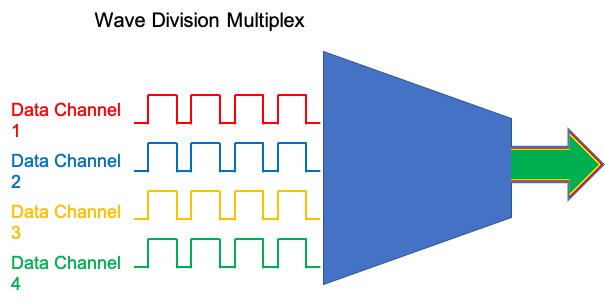
Mode Dispersion
Mode dispersion does not occur in single-mode fiber. However, it does occur in multi-mode fiber applications when different light modes exit the fiber at different times, even though they enter simultaneously. This phenomenon arises because the velocities of the light modes vary, despite the refractive index being uniform within the core. Mode dispersion can cripple high-speed data signaling. As a pulse travels through a fiber, dispersion causes it to spread out. This pulse spreading restricts both the distance and the bit rate of data transmission over the optical fiber. As pulse spreading increases signals errors can occur where 2 bits look like one.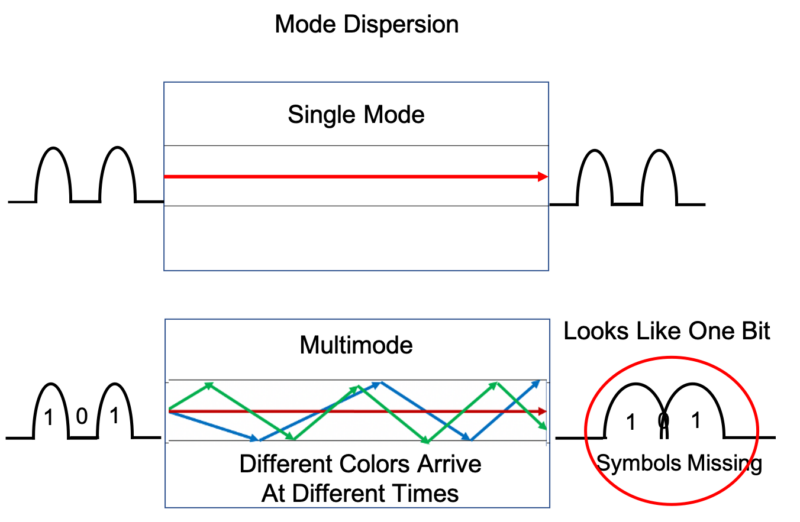
Types of Single-Mode Optical Fiber: Single-mode fibers are categorized based on their dispersion properties and specific applications:
1. Standard Single-Mode Fiber (SSMF or G.652):
o Characteristics: Designed for general-purpose use with low attenuation and dispersion.
o Applications: Widely used in telecommunications and data communications for long-haul and metro networks.
2. Dispersion-Shifted Fiber (DSF or G.653):
o Characteristics: Engineered to minimize chromatic dispersion at the 1550 nm wavelength, where fiber loss is minimal.
o Applications: Initially designed for high-speed long-distance communication, but less common today due to non-linear effects in WDM systems.
3. Non-Zero Dispersion-Shifted Fiber (NZDSF or G.655):
o Characteristics: Designed with a small, controlled amount of dispersion in the 1550 nm window to avoid non-linear effects while supporting high-capacity WDM systems.
o Applications: Used in long-distance and ultra-long-distance optical networks, especially in dense wavelength division multiplexing (DWDM) systems.
4. Low Water Peak Fiber (LWP or G.652C/D):
o Characteristics: Reduced attenuation in the 1400 nm water absorption peak, allowing for extended transmission windows.
o Applications: Enhances the usable wavelength range for telecommunications, supporting more channels in WDM systems.
Advantages of Single Mode Optical Fiber:
High Bandwidth: Single-mode fibers offer significantly higher bandwidth compared to multi-mode fibers, making them suitable for high-speed data transmission.
1. Long-Distance Transmission: With lower attenuation and dispersion, single-mode fibers can transmit signals over much longer distances without significant loss of signal quality.
2. Low Attenuation: The small core and single light path reduce signal attenuation, maintaining signal strength over long distances.
3. Future-Proofing: As demand for higher data rates continues to grow, single-mode fibers are more capable of supporting future network upgrades and technologies.
Limitations of Single Mode Optical Fiber:
1. Higher Cost: The production and installation of single-mode fibers and the associated equipment are generally more expensive than those for multi-mode fibers.
2. Complex Installation: The small core diameter requires precise alignment and splicing, making the installation process more complex and costly.
3. Specialized Equipment: Single-mode systems require more specialized and costly transceivers and other networking equipment, adding to the overall expense.
Applications of Single-Mode Optical Fiber
1. Telecommunications: Single-mode fibers are the backbone of global telecommunications networks, enabling long-distance, high-capacity communication links.
2. Internet Backbone: Essential for the high-speed internet backbone, supporting data transmission between cities, countries, and continents.
3. Cable Television (CATV): Used to deliver high-definition television signals over long distances with minimal loss.
4. Enterprise Networks: Employed in large-scale enterprise networks that require reliable, high-speed connections across extensive geographic areas.
5. Data Centers: Facilitates high-speed connections within and between data centers, supporting cloud computing and large-scale data storage.
6. Military and Aerospace: Used in secure communication systems and avionics due to their high reliability and resistance to electromagnetic interference.
Single-mode optical fiber is a critical component of modern communication infrastructure, offering unparalleled performance for long-distance and high-bandwidth applications. Its high bandwidth, low attenuation, and ability to transmit signals over long distances make it indispensable for telecommunications, internet backbone, and various high-speed data communication applications.
Multi-Mode Fiber
Multi-mode optical fiber is a type of optical fiber primarily used for short-distance data communication and various applications in local area networks (LANs), data centers, consumer electronics, and other environments. Multi-mode fibers allow multiple light rays, or modes, to propagate through its core. Understanding these modes is crucial for optimizing the performance of optical networks.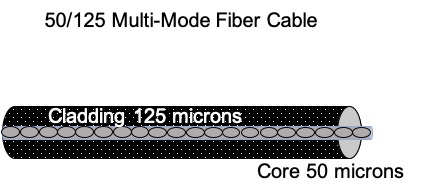
Multi-mode optical fiber is distinguished by its larger core diameter compared to single-mode fiber, allowing multiple modes of light to propagate. Key characteristics include:
1. Core Diameter: Typically ranges from 50 to 62.5 microns, significantly larger than the 8-10 microns of single-mode fibers.
2. Cladding Diameter: Standardized at 125 microns, identical to single-mode fibers, providing compatibility with similar splicing and connector hardware.
3. Numerical Aperture (NA): Multi-mode fibers have a higher NA, indicating a larger acceptance angle for incoming light, which simplifies coupling with light sources such as LEDs and VCSELs (Vertical-Cavity Surface-Emitting Lasers).
Types of Optical Multi-Mode (OM) Fiber
Multi-mode fibers are categorized based on their bandwidth and performance specifications. The greater the OM number the better the performance:
1. OM1:
o Core Diameter: 62.5 microns.
o Bandwidth: Up to 200 MHz·km.
o Applications: Older LAN systems and some data center applications.
2. OM2:
o Core Diameter: 50 microns.
o Bandwidth: Up to 500 MHz·km.
o Applications: Upgraded LAN systems and data centers, supporting higher data rates over short distances.
3. OM3:
o Core Diameter: 50 microns.
o Bandwidth: Up to 2000 MHz·km.
o Applications: Optimized for laser sources, supporting 10 Gb/s over 300 meters, commonly used in modern data centers.
4. OM4:
o Core Diameter: 50 microns.
o Bandwidth: Up to 4700 MHz·km.
o Applications: Extended support for 10 Gb/s up to 550 meters, and 40/100 Gb/s up to 150 meters.
5. OM5:
o Core Diameter: 50 microns.
o Bandwidth: Similar to OM4, with additional support for Short Wavelength Division Multiplexing (SWDM).
o Applications: Designed to support data rates of 40/100 Gb/s and beyond, future-proofing for high-speed networks.
Light Propagation in Multi-Mode Fiber
Basic Principles
Light propagation in optical fibers is governed by the principles of refraction and total internal reflection. Since the core of a multi-mode fiber is large, typically with a diameter of 50 or 62.5 microns, multiple light paths (modes) can be transmitted. These modes are categorized into different types based on their propagation characteristics:
Fundamental Mode (LP01)
• The fundamental mode is the lowest order mode and exhibits the simplest structure.
• It has a Gaussian intensity distribution and propagates with minimal dispersion.
Higher Order Modes (LP11, LPO21, LP 02, etc)
• Higher-order modes have more complex structures and greater dispersion.
• These modes exhibit multiple intensity peaks across the fiber cross-section.
• They tend to travel at slightly different speeds, causing mode dispersion.
Types of Multi-Mode Fibers
Step-Index Multi-Mode Fiber
To review, the refractive index of the core must be higher than that of the cladding to achieve total internal reflection, effectively trapping the light within the core. In a step-index fiber, light reflects only at the core cladding interface allowing for an immediate reflection ricocheting every time it moves on to its next reflection.
Graded-Index Multi-Mode Fiber
With Graded-Index the refractive index gradually decreases within the graded-index core causing the light to bend slightly and follow a curved path.
• The core refractive index gradually decreases from the center to the cladding.
• Reduces mode dispersion by equalizing the travel time of different modes.
• Provides higher bandwidth and better performance over longer distances.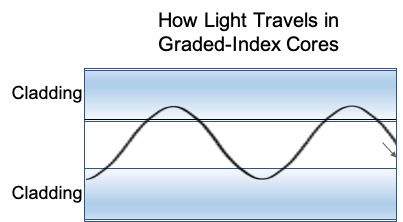
Advantages of Multi-Mode Optical Fiber
1. Cost-Effective: Multi-mode fibers are generally less expensive than single-mode fibers for short-distance applications due to the use of cheaper light sources like LEDs and VCSELs.
2. Ease of Use: The larger core diameter simplifies alignment and splicing, making installation and maintenance easier.
3. High Data Rates for Short Distances: Multi-mode fibers can support high data rates (10 Gb/s, 40 Gb/s, and even 100 Gb/s) over short distances, making them ideal for data centers and LANs.
4. Broad Acceptance Angle: The higher numerical aperture allows for easier coupling with light sources, reducing the complexity of the optical system.
Limitations of Multi-Mode Optical Fiber
1. Limited Distance: Due to mode dispersion, multi-mode fibers suffer from greater signal attenuation and bandwidth limitations over longer distances, typically up to 600 meters for high-speed applications.
2. Mode Dispersion: Multiple light paths (modes) can cause pulse broadening and signal distortion, limiting the maximum achievable data rate over longer distances.
3. Lower Bandwidth: Compared to single-mode fibers, multi-mode fibers have a lower bandwidth-distance product, making them unsuitable for long-haul telecommunications.
Applications of Multi-Mode Optical Fiber
1. Local Area Networks (LANs): Widely used in LANs to connect end-users to the network backbone, supporting various data rates and network topologies.
2. Data Centers: Essential for intra-data center connectivity, linking servers, storage systems, and network switches with high-speed, short-reach connections.
3. Building Interconnects: Ideal for campus networks and building-to-building links within a limited geographical area.
4. Enterprise Networks: Used for internal communication within corporations, educational institutions, and other organizations requiring robust and high-speed data transmission.
5. Audio/Visual Applications: Employed in multimedia systems, including video conferencing and broadcasting, due to their ability to handle high-bandwidth audio and video signals.
Future Perspectives: The evolution of optical fiber materials is far from over, with ongoing research aimed at pushing the boundaries of performance and functionality. As demand for high-speed, high-capacity communication networks continues to grow, materials innovation will play a crucial role in shaping the future of fiber optics. Whether enabling next-generation data centers, powering 5G networks, or facilitating breakthroughs in medical imaging and sensing, optical fiber materials will remain at the forefront of technological progress.
In Part 2 of This Series
We will start by examining the electronics used to convert signals to light and back, showcasing their vast potential. Next, we’ll explore the various configurations of optical fiber cables, detailing the different types of assemblies from single to multiple fibers, as well as the integration of copper, which is extensively used in consumer digital video. Additionally, we’ll leverage DPL Labs’ extensive R&D project in this technology to help guide users in choosing the correct optical fiber cable for selective applications.
Stay tuned, and we’ll see you next time!


